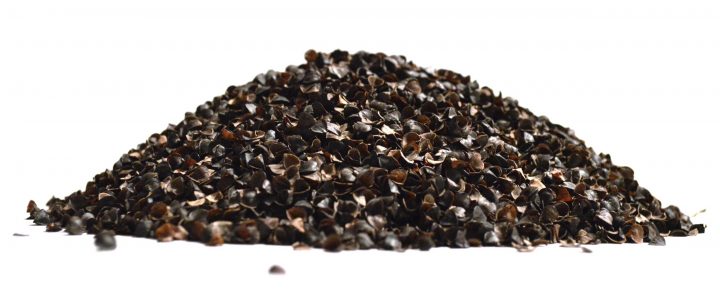
Before we discuss the nuances of buckwheat hull mulch, let’s consider just what mulch is and what benefits it provides. Mulch with clean, sharp edging obviously looks great. Because the aesthetic improvement is so appreciated, homeowners overlook the other advantages to mulching. There are important reasons to add it to your property. Why should you mulch?
Mulching helps:
- regulate soil temperatures. It creates a barrier protecting soil from cold winter air, insulating and protecting it and the plants it hosts until spring.
- curtail weed growth. Mulch prevents sunlight from reaching seeds. It also keeps them from reaching the soil beneath, which is required for most seed’s germination.
- slow evaporation. It prevents dry air from pulling the moisture out of your soil and plants.
- reduce soil erosion. Protecting your soil’s surface from wind and rain will minimize the impact of both falling rain water and blowing winds.
- improve soil nutrition. Decomposing organic material in mulch will provide nutrients to aid growing plants.
I’ve been using wood chips for years and it works well.
It’s hard to find fault with traditional wood chip mulch. It works pretty darn well and it’s dirt (er… mulch) cheap. In fact, many cities give it away for free. For these reason, it’s great for large areas.
That said, you might want to avoid some wood mulch types. Dyed mulches (red is the most popular) are often made from recycled materials like pallets or construction waste. These wood chips are dyed to make product appear more uniform. It sounds great in principle, recycling old wood. Unfortunately this material sometimes contains toxic chemicals. For example, recycled lumber often contains the poison arsenic, a known carcinogen. I wouldn’t spread that around my home!
What is buckwheat hull mulch?
Most big box landscaping supply stores don’t carry buckwheat hull mulch. It’s a specialty item that’s suited for use in smaller garden plots, individual planters or for potting soil mixes.

Buckwheat hulls are much more resistant to absorbing valuable water than wood mulch.
They’re (mostly) non-absorbent. This characteristic allows much more water to penetrate the mulch down into to the soil. The hulls then shield the soil below from the elements, helping it retain that moisture. Their resistance to water absorption also helps them last longer than wood mulch.
Buckwheat hull mulch should be applied in a layer no more than 1 ½ inches thick. That’s all that’s necessary for it to be effective. Just like other mulch types, too much will reduce the underlying soil’s oxygen levels.
Moisture sensitive plants such as roses, vegetables and perennials benefit from a buckwheat hull and potting soil mixture.
You can’t mix wood mulch and potting soil because it can cause a nitrogen deficiency. Buckwheat hulls offer a soil mixture nutrients and aeration without this issue.
They are susceptible to wind erosion.
Buckwheat hulls are lightweight and can be caught in the wind if it’s out in the open. Be aware that your nicely manicured plants could quickly become less than impressive on a windy day. Keep your buckwheat hulls confined to areas where the wind can’t catch them. They’re popular for use in raised bed planters, as they’re protected from the wind.
I learned the benefits of buckwheat hull mulch when I replaced my first buckwheat pillow’s filling.
I’d never tried buckwheat hull mulch until recently. My 10 year old buckwheat pillow needed a refill, so I had about 10 pounds leftover after replacing the hulls with new ones. I used it around my newly planted oakleaf hydrangea. That single mulch application helped the plant thrive and survive a its first cold Michigan winter. Since that worked so well, every time someone in our house replaces their pillow filling, we reuse the hulls outside in our garden.

If you’ve got an older buckwheat pillow or two that could use new filling, you can feel good about replacing it.
While an old memory foam or polyester pillow will lie forever in a landfill, your used hulls will get a second life. Buckwheat hull mulch will provide your landscape with beautiful texture and give nutrients and protection to its soil.
